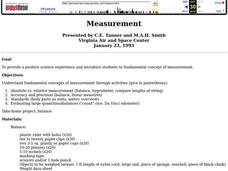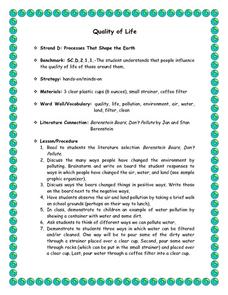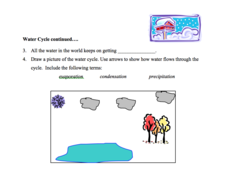Curated OER
Scientific Tools
Students list different uses for common scientific instruments. They identify appropriate instruments to measure length, temperature, and mass. Pupils are given a copy of the "Science Tools" task sheet, students place the correct number...
Curated OER
Soil Buffering
High schoolers observe the pH change of an acid mixture poured over soil in a filter. Since the buffering capability of soils differs, you may want to do this experiment with several different soil types.
Curated OER
Observing The Influence Of Acid Rain On Plant Growth
Students observe one of the direct effects of acid water on plant growth. Students engage in an experiment which will take about 2 weeks. Students will understand the effect that acid rain has on plant growth.
Curated OER
Looking At Acid's Effects On Metals
Students perform an experiment that demonstrates acid rain. The chemical effect of acids on metals may take at least five days for the human eye to see, even though the reaction starts as soon as the acid contacts the metal.
Curated OER
Measurement
Students experience a positive science experiment and study fundamental concepts of measurement.
Curated OER
Measuring pH
Students perform an experiment which will illustrate how to measure the approximate pH of chemicals in water using a pH indicator. They understand that a pH indicator is a chemical that changes color when it comes in contact with acids...
Curated OER
Acid Rain Lesson Plan Activity 2 - Understanding the Difference Between an Acid And a Base
Learners experiment to determine the difference between an acid and a base. They study the concept of adding a buffering agent to make an acid more basic. They study the pH scale.
Curated OER
Photosynthesis: Intake of Carbon Dioxide - Production of Oxygen
Students, after a long-term observation of photosynthesis with aquatic plants, assess the benefits of photosynthesis towards all living organisms. They explain in their own words the two cycles within photosynthesis. Guided discussion...
Curated OER
Chemistry: Metals and Non-Metals
Students conduct an experiment to test the reactivity of metals and non-metals. In this chemistry lesson students test metals with different chemicals to observe the reaction. The results are used to categorize the metals.
Curated OER
Newton's First Law of Motion with a Glider
Third graders examine, analyze, study and memorize Newton's First Law of Motion utilizing a glider to demonstrate the process. They state, sing, draw or enact an example/illustration of Newton's First Law of Motion in front of their...
Curated OER
Lung Limit
Students determine their lung capacity by completing a science experiment with a bottle of water. In this lung science lesson, students discuss the lungs' purpose. Students complete an experiment to determine their lung capacity using a...
Curated OER
Understanding Salinity
Students discuss why the ocean is salty. They discuss what salinity is. Students are told that is they want to know how much salt is in a body or water, they would use a special scientific tool. They complete an Estuarine Layers science...
Curated OER
Build Your Own Hovercraft
Students construct a hovercraft following specific procedures. In this technology lesson, students explain the physics principles behind hovercraft. They compare and contrast this machine with the aircraft.
Curated OER
Forces and Motion
Young scholars build parachutes for chicken eggs. In this physics lesson, students describe the forces acting on a falling object. They predict which of the three parachute models they made has the best chance of keeping the egg intact...
Curated OER
It's Really Heating Up in Here!
Students create and observe a greenhouse effect model and discuss the implications of global warming theory for engineers, themselves and the Earth. They discover that Global warming is becoming an increasing concern as we learn more...
Curated OER
Quality of Life
Students discover that people influence the quality of life of those around them. They read the literature selection 'Berenstein Bears, Don't Pollute' and discuss the many ways people have changed the environment by polluting.
Texas Instruments
Can You Breathe Like a Pinniped?
Young learners compare the breathing patterns of different animals in this pinniped lesson. They examine the breathing pattern of California sea lions and northern elephant seals. Pupils collect, compare and analyze data concerning...
Curated OER
Water Rocket
Students study the basic operation of a water rocket. In this propulsionlesson students complete several experiments on constructing a bottle rocket launcher.
Curated OER
How Do Probes Get To Space
Students investigate how force works to propel rockets into outer space. In this physics lesson, students use a drinking straw, fishing line, a balloon, and tape to explore how force works in outer space. Students repeat the experiment...
Curated OER
I Need Room to Breathe
Seventh graders explore how exercise affects carbon dioxide levels in exhaled air.
Curated OER
Energy Transfer
Students investigate the properties of heated air. They make predictions about what they think makes the wind blow on a worksheet, and conduct two experiments to demonstrate the properties of heated air. Students heat a bottle until a...
Curated OER
Charles' Law
Students determine the validity of Charles' Law. In this Charles' Law lesson plan, students measure the volumes of a gas at two different temperatures. They determine the volume at a high temperature and predict using Charles' Law what...
Curated OER
Water, Water Everywhere!
Learners brainstorm on ways they use water, and where water comes from. They view video, Down the Drain, to gain specific facts about water use, properties of water, problems of water and the water cycle. They perform a lab activity...
Rochester Institute of Technology
Heat Transfer
Use an exciting role play activity to teach young chemists about the importance of heat transfer in maintaining homeostasis. They assume the role of a dog sled owner who has been abandoned and must fend for themselves with only a...























